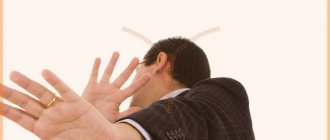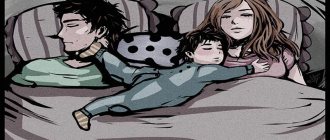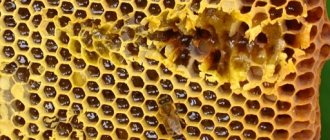- October 6, 2018
- Manias and Phobias
- Natalie Lynn
Insectophobia, also known as entomophobia, literally translates as fear of insects. This phobia is one of the subtypes of zoophobia and, in turn, is divided into several subtypes, for example, apiophobia - fear of bees, arachnophobia - fear of spiders, myrmecophobia - fear of ants, acarophobia - fear of ticks. Therefore, if you want to know what the fear of insects is called, you should clarify which species you are interested in.
The review will talk about insectophobia. It refers to an irrational fear of some or all types of insects. Fear mainly arises in humans due to aversion towards various insects due to their shape, color and also because they spread many diseases.
A phobia that originates in a person makes his life very uncomfortable. An insectophobe may not even leave the house, for fear of noticing any insect outside of it. Fear also gives rise to “delusional parasitosis,” when the patient begins to experience sensations such as tingling, itching, crawling on his skin, and react accordingly to them - try to remove a non-existent insect from his body, wash it off or scratch the skin until it bleeds, which, in in turn, can lead to infection. A person suffering from insectophobia may also develop OCD, or obsessive-compulsive disorder. It creates a desire to constantly clean the living space and complicates a person’s mental and physical condition.
Causes of insectophobia
Why are people afraid of insects? There are many reasons that can cause insectophobia, or fear of insects, in a person. The reasons can be divided into two main categories.
Objective factors:
- Lived experience. It often happens that a person develops a disease of fear of insects after being bitten by a bee, mosquito, etc. A similar experience experienced in childhood can lead to psychological trauma, which develops into insectophobia.
- Imitation of others. If there is a person in the family who suffers from insectophobia, the child can learn from him not only to be wary of insects, but also to reinforce the fear, degenerating it into a full-fledged phobia.
- Medical problems. If you have been through a traumatic experience in your personal life due to loss of someone or divorce, the level of stress can create fear in you. Poor mental health, mental retardation and anxiety problems, or poor physical condition due to hyperthyroidism, folate and thiamine deficiency can also contribute to the onset of a phobia. Diseases such as syphilis, meningitis, cirrhosis can give rise to a phobia in you. Schizophrenia is another significant reason for the development of a phobia.
Environment. A person may feel like something is crawling on their body, but this sensation may be due to skin irritation caused by static electricity, pollen deposits and allergens on the pores of the skin or products containing, for example, formaldehyde.
Contrived factors:
- Thoughts of harm. Many patients constantly think about how certain insects can harm them: whether their bites are poisonous, whether they carry infections, and the like. Such thoughts, which may initially be quite rational, gradually become obsessive and contribute to the formation of insectophobia.
- Fantasy. If the previous point was based on objective information and the macrocosm, then in this case the whole problem lies in the patient’s wild imagination. Without any special knowledge about insects, a person imagines them as terrible monsters capable of causing him great harm.
- Literature, cinema, computer games, etc. Images depicting terrible insects, which often do not correspond to reality, an artistically exaggerated description of harm contribute to the formation of insectophobia,
Causes of insectophobia
Is there a definite answer to the question why people are afraid of insects? Behavioral psychologists (behavioral therapy) distinguish two ways in which phobias arise:
- Conditional;
- Simulated.
Conditional path
- Childhood injuries - discomfort from bites or sounds, severe fear;
- Adult trauma – memories of a sudden attack by a creature or severe pain.
Simulated path
- In childhood, the child copies the behavior of loved ones, the behavior model is stored in the head and in the future can provoke the development of panic;
- Parents prohibiting their child from touching insects - the child’s brain perceives the creature as something scary and negative;
- External influence - books, films or news.
The good news is that this condition can be treated. But first it’s worth talking about the main signs of the disease.
Signs and symptoms
Symptoms that may indicate entomophobia or insectophobia:
- Constant complaints of insect bites are the main symptom of insectophobia, that is, a phobia such as fear of insects.
- Reclusion.
- Reading about insects to see if fear is rational.
- Obesity.
- Frequent visits to doctors due to skin problems.
- When thinking about insects, physical tension appears, expressed in symptoms such as shortness of breath, nausea, and vomiting.
- A panic attack at the sight of an insect is also a sign of insectophobia.
- Isolation from society.
The symptoms are so common that a person often does not realize that they are developing a phobia - the fear of insects. The main symptoms of any phobia are:
- Panic when confronted with the cause of fear or even at the thought of the source of fear.
- The desire not to leave the house in order to avoid confrontation with the source of fear.
- A feeling of powerlessness due to the fact that a person cannot control fear, even knowing that it is irrational.
- The children start crying.
- Development of physical symptoms such as inability to breathe, sweating, and vomiting.
Symptoms of insectophobia
The fear that arises in a person at the sight of insects or even when thinking about them is accompanied by characteristic symptoms:
- Signs of panic that the patient is unable to cope with on his own. He is trying to run away from the cause of his fear, to hide from it.
- Pallor or redness of the skin. This is one of the symptoms of a panic attack.
- The emergence of a sharp need to use insecticides or other means that repel insects. This action is seen as an attempt to temporarily solve your problem.
- Wear protective clothing and masks when walking outdoors.
- Refusal to go out into nature, so as not to expose yourself to insects again.
Symptoms of a phobia also include an unreasonable expectation of danger, in this case the appearance of hated insects in the field of view.
Tests for diagnosing insectophobia
Currently, there are no proper tests to identify a specific phobia, so doctors turn to the Diagnostic and Statistical Manual of Mental Disorders, published by the American Psychiatric Association, to test various criteria for identifying insectophobia. The guideline also suggests the type of treatment that can be administered to the patient. During therapy sessions, you will be asked various questions, and your response to them will serve to determine the phobia. Your medical and psychological history and heredity will also help doctors in the identification process.
The main criteria that help diagnose insectophobia are:
- A feeling of intense fear and irritation when the patient notices an insect or even sees a picture of it.
- Fear even at the thought of insects.
- Avoiding encounters with any insects or even viewing images of insects.
- Avoidance of all types of social activities that occur outside the home so that the patient can avoid encounters with insects. When an insect approaches a person, he noticeably tenses up.
- Symptoms of the phobia continue for more than 6 months.
It is worth noting that fear of insects is inherent in most people, but in order to determine which fear of insects is a phobia in its pure form, it is still worth contacting a specialist. He is the one who will help you understand and establish an accurate diagnosis.
Signs and Symptoms of Fear of Insects
The main symptom of insectophobia is panic fear when in contact with an insect. At the mere thought of meeting the object of fear, an insectophobe panics. In addition to increasing anxiety, a number of somatic reactions are noticeable:
- nausea,
- vomit,
- arrhythmia,
- tachycardia,
- chest pain,
- headache,
- feeling of suffocation
- dizziness,
- presyncope and fainting.
At such moments, a person thinks that he will go crazy and die. Therefore, the insectophobe begins to avoid meeting the object of fear. If you cannot avoid the meeting, then the insectophobe’s reactions become inadequate. Some people try to run away or hide, others become aggressive and try to destroy the insect.
Independent actions
If the case is not advanced and your phobia is at the initial stage of development, it is important to understand what exactly is bothering you - what insects and possible causes of fear. By answering these questions yourself, you can choose how to deal with your fear of insects.
- If you are afraid of the unknown or there is no information about this or that representative of the macrocosm, you should read an encyclopedia about insects, study pictures, detailed descriptions. You can also watch documentaries, just make sure (ask someone to watch the film in advance) that it does not contain scenes that frighten you, for example, contact of insects with people, insect attacks on humans, etc. This method is suitable for both children, as well as for adults.
- If the cause of your fear is a feature film, you should watch it again, not forgetting that everything that happens on the screen is fiction. When using this method with children to help them get rid of their fear of insects, think carefully about the approach, otherwise the situation may only get worse.
- If insects are simply unpleasant to you, for no apparent reason, consider buying photo wallpaper depicting representatives of the macrocosm. Souvenirs and accessories will also help - having gotten used to seeing only decorations in an insect, a person will gradually forget about fear.
Symptoms
In both cases, the person may experience bodily symptoms such as:
- dizziness and weakness;
- cold sweat;
- nausea and other manifestations of fear from the gastrointestinal tract;
- rapid heartbeat and shortness of breath;
- chest pain;
- muscle tremors;
- feeling of loss of control over oneself.
With very strong fear, fainting is possible.
Those phobics who are more afraid of their aversion to spiders and insects than of the potential danger posed by these creatures usually suffer not only from a phobia of arthropods, but also have other neurotic disorders (panic, generalized anxiety, etc.).
In principle, these people are more afraid of themselves, their physiological reactions (nausea, tachycardia, etc.) than of insects. Therefore, such disturbing thoughts are rarely isolated. After all, you can be scared and disgusted anywhere and anytime.
Treatment of insectophobia
If the methods listed above did not help you cope with the problem, be sure to seek help from a professional.
Entomophobia, or insectophobia - as the fear of insects is called - is often mistakenly considered a mental illness. Because this phobia is not well documented in the list of similar disorders, doctors are often unable to identify it. The patient remains without proper treatment for a long time. Therefore, the diagnosis of phobia is very important and multidisciplinary approaches should be taken.
Some therapeutic treatments for insect phobia along with prescribed medications allow the patient to remain calm and in control. Often during psychotherapy, an entomologist is brought in for consultation to help the patient understand that his fear is irrational.
Ways to get rid of fear
Insectophobia can be successfully treated . You can try to cope with it on your own. There are some tricks for this. But it is better to seek help from professional psychotherapists who guarantee that this fear will be overcome after undergoing therapy.
In order to attempt to get rid of this problem on your own, you need to try the following steps:
- You need to find out some interesting information about the world of insects. To do this, you need to purchase colorful books that tell about this world. There are encyclopedias that describe the life of insects in detail. This approach is suitable for both children and adults. When a person learns in more detail about how the creatures that cause him fear live, the fear may recede.
- Decorate your living space with images of insects. Some manufacturers specially produce wallpaper collections with this print. They depict representatives of the insect world in all their diversity. Such collections are mainly bought by people who have such a phobia. You don't have to limit yourself to just wallpaper. There are many ways to decorate your space with insect keepsakes. They can be quite cute if they are beautifully decorated and placed in the right place. Over time, constantly being surrounded by insects, a person stops reacting violently to them. Many people successfully cope with this fear using this method.
- If fear is caused after watching a feature film where arthropods are not shown in the best light, then it is worth watching a video telling about their way of life. It would be better if you could find films that show how safe they are and in what cases you should be wary of them. After all, most insects are harmless. Many peoples even eat them.
Desensitization, or exposure therapy, to treat insectophobia
Desensitization or exposure therapy to treat insectophobia helps overcome fear by exposing the patient to the object of fear. For example, the first images of insects are shown so that the patient can influence and reduce his level of anxiety. Slowly, as the patient begins to understand that not all insects are harmful, he is taken out into the garden where he may come into contact with flies or bedbugs.
Diagnosis of insectophobia
There are no special tests to diagnose insectophobia. The psychologist seeks out and analyzes a triad of phobic symptoms: anxiety upon contact with an insect, somatic manifestations of fear, avoidance reaction. A psychologist talks with a client and analyzes his complaints. It is easy to suspect inappropriate reactions when encountering an insect. You can do this yourself, but only a doctor can make a diagnosis and prescribe treatment. Self-medication and self-diagnosis are dangerous.
Medicines for the treatment of insectophobia
Although medications cannot reduce insectophobia, they can help you control the physical symptoms that arise from the phobia.
- Antidepressants are called serotonin reuptake inhibitors, which control your mood by working as neurotransmitters in your brain. Antidepressants are prescribed according to your condition.
- Sedatives for insectophobia are those medications that are also known as benzodiazepines and help calm your nerves and make you less anxious. But at the same time, you should be careful while taking these pills as you may develop addiction and there may also be adverse effects if you take alcohol.
- Beta blocker medications block the stimulating sensations you experience due to entomophobia. The medicine also reduces heart rate caused by anxiety. A small amount may improve your condition for a while.
How is insectophobia expressed?
Insectophobia is distinguished by clearly defined symptoms - all of them appear both in the presence of an object of panic, and when thinking about a possible causative agent of fear. You can identify several main symptoms that distinguish a phobia when you are afraid of insects:
- Severe fear when confronted with a pathogen - panic attacks, tremors of the limbs and rapid heartbeat/breathing/blood pressure;
- The patient is faced with an obsessive thought about a possible meeting - he does not want to go outside, puts on tight, closed clothes and begins to protect the house;
- The insectophobe is tense and listens to sounds, trying to identify the moment the creature approaches.
You have learned what the fear of insects is called, what symptoms it differs in - it’s time to figure out how to get rid of it.
Risk factors
There are several factors that may put you at risk of developing a phobia:
- If you notice that anyone close to you, such as father, mother, brother, etc., suffers from insectophobia, you risk developing this fear in yourself as well.
- If you have experienced a traumatic incident in the past, you may develop fear of the source.
- Specific phobias develop even at the age of 10, so you become unable to interact with people.
What is insectophobia
The name is derived from the Greek words insecto, which means “insect,” and phobos, which translates as “fear.” Insectophobia is a subtype of zoophobia. Insectophobia is an irrational, panicky fear of insects. An alternative name is entomophobia.
It is more common to be afraid of a particular type of animal, rather than all of them. For example, someone suffers from a phobia only of flying or buzzing insects, someone is afraid only of spiders, and someone is afraid of only large insects, etc.
What is a person suffering from insectophobia afraid of? Pain, death, bite, poisoning and other possible consequences of contact with an insect.
Fear of insects has several subtypes (the subject of fear is indicated in parentheses):
- cnidophobia (scorpions and other stinging animals);
- acarophobia (ticks);
- isopterophobia (termites and other animals that eat wood);
- apiphobia (bees and wasps);
- lepidopterophobia (butterflies);
- dipterophobia (flies);
- arachnophobia (spiders);
- scoleciphobia (worms and maggots);
- myrmecophobia (ants).
Note! Most insectophobes refuse to visit a psychologist. They believe that you can live quite normally with this fear, you just need to avoid meeting the animal. But in reality this is not so, the tension remains constant.
Complications
A phobia that bothers someone and causes serious problems in their life may not seem like a concern to others. A patient suffering from insectophobia may have many complications, such as:
- Avoiding any social interaction because of the thought that people might laugh at him. This behavior can lead to reclusiveness and loneliness.
- The complication of insectophobia leads to clinical depression or develops anxiety disorders.
- Substance abuse to cope with stress caused by fear.
Causes of fear
There are two main theories that underlie the explanation of the origin of all existing phobic disorders.
Dr. Freud's psychodynamic theory explains fear by the fact that man, in the process of evolution, claimed dominance and complete subjugation of nature. So, he got rid of all fears, but some still penetrated into the subconscious. Therefore, phobias cannot be controlled - they are deeper, in the subconscious. Our ancestors were afraid of insects that stung painfully and could cause death. This fear has evolved to us.
Another explanation is more popular today. Most scientists are inclined to believe that phobia occurs during a real or simulated traumatic situation. So, a child can get a bite, experience pain and remember it. Or fear will be caused by repeating adult behavior patterns. Parents are afraid of bees, tell their children that they sting painfully, and the child begins to fantasize. And fantasy can be worse than reality for impressionable children. This is how a real irrational fear of insects appears.











